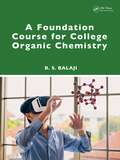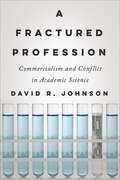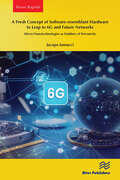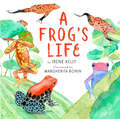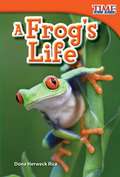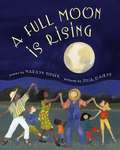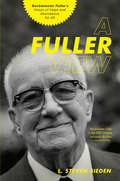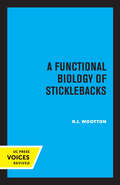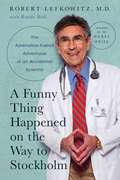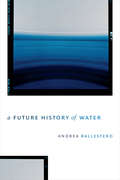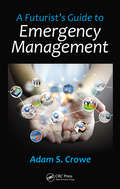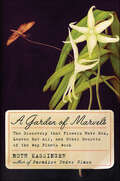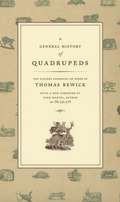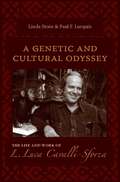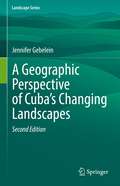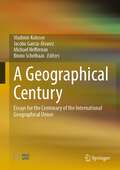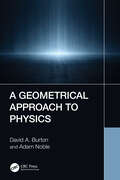- Table View
- List View
A Foundation Course for College Organic Chemistry
by B. S. BalajiTo understand and improve the underlying principles that govern how organic reactions occur, A Foundation Course for College Organic Chemistry follows a brick-by-brick building approach. Emphasis is given to interrelating experimental facts and findings with predictions (mechanism) and inferences (results). Discussions focus on clarifying how complex organic reactions occur, which is based on electronegativity differences, movement of electrons (through σ framework or π bonds), and addition or removal of atoms (hydrogen, halogens) or groups (hydroxy, amino).The book begins with simple rules governing the deconstruction of reactions and applies them to explain how esterification, amide, and cyanide hydrolysis reactions proceed. The importance of stereochemistry (used in drug development, biology, and medicine), aromatic electrophilic and nucleophilic substitutions, reaction kinetics, and dynamics is explained with suitable examples.Features: A systematic and structured approach is used to study all aspects of reactive intermediates (generation, structure, geometry, and reactions of carbocations, carbanions, and carbon-free radicals) This book incorporates scientific methods to deduce reaction mechanisms with simple and relevant explanations, and limitations A proper explanation is given to understand the influence of functional groups on the stability and reactivity of intermediates, pKa, HSAB principles, structure-activity relations, and how these can be exploited in organic chemistry Information is presented in an accessible way for students, teachers, researchers, and scientists
A Fox Found a Box
by Ged AdamsonWhen his radio breaks, a little fox finds that the forest is filled with its own rhythm and music--drip drops and chirp chirps--in this picture book that gently introduces the concept of mindfulness.A little fox is digging for food when--OUCH! What is that?--the fox finds a box! When the fox brings the box home to his animal friends--and turns a funny-looking knob--the box starts to sing, and music fills the forest. Everyone agrees that it feels nice. Day and night, they listen to the box's songs, until, one day, it goes quiet. No matter what they try, they just can't get the box to sing again. The animals stop swishing their tails and flapping their wings.... But, in the silence, the fox hears the drip-drop rhythm of melting icicles and the thump thump of a beaver's tail and comes to realize music is everywhere. The noises of the forest and the animals build into a symphony, until, eventually, everyone joins together in a joyous dance party. From the author of fan favorite Douglas, You Need Glasses!, here is a wonderful celebration of music--and appreciating the little things that have surrounded you all along.
A Fractured Profession: Commercialism and Conflict in Academic Science (Critical University Studies)
by David R. JohnsonExploring the growing division among academic scientists over a profit motive in research.The commercialization of research is one of the most significant contemporary features of US higher education, yet we know surprisingly little about how scientists perceive and experience commercial rewards. A Fractured Profession is the first book to systematically examine the implications of commercialization for both universities and faculty members from the perspective of academic scientists. Drawing on richly detailed interviews with sixty-one scientists at four universities across the United States, sociologist David R. Johnson explores how an ideology of commercialism produces intraprofessional conflict in academia.The words of scientists themselves reveal competing constructions of status, conflicting norms, and divergent career paths and professional identities. Commercialist scientists embrace a professional ideology that emphasizes the creation of technologies that control societal uncertainties and advancing knowledge toward particular—and financial—ends. Traditionalist scientists, on the other hand, often find themselves embattled and threatened by university and federal emphasis on commercialization. They are less concerned about issues such as conflicts of interest and corruption than they are about unequal rewards, unequal conditions of work, and conflicts of commitment to university roles and basic science.Arguing that the division between commercialists and traditionalists represents a new form of inequality in the academic profession, this book offers an incisive look into the changing conditions of work in an era of academic capitalism. Focusing on how the profit motive is reshaping higher education and redefining what faculty are supposed to do, this book will appeal to scientists and academics, higher education scholars, university administrators and policy makers, and students considering a career in science.
A Framework for K-12 Science Education
by Helen QuinnScience, engineering, and technology permeate nearly every facet of modern life and hold the key to solving many of humanity's most pressing current and future challenges. The United States' position in the global economy is declining, in part because U. S. workers lack fundamental knowledge in these fields. To address the critical issues of U. S. competitiveness and to better prepare the workforce, A Framework for K-12 Science Education proposes a new approach to K-12 science education that will capture students' interest and provide them with the necessary foundational knowledge in the field. A Framework for K-12 Science Education outlines a broad set of expectations for students in science and engineering in grades K-12. These expectations will inform the development of new standards for K-12 science education and, subsequently, revisions to curriculum, instruction, assessment, and professional development for educators. This book identifies three dimensions that convey the core ideas and practices around which science and engineering education in these grades should be built. These three dimensions are: crosscutting concepts that unify the study of science through their common application across science and engineering; scientific and engineering practices; and disciplinary core ideas in the physical sciences, life sciences, and earth and space sciences and for engineering, technology, and the applications of science. The overarching goal is for all high school graduates to have sufficient knowledge of science and engineering to engage in public discussions on science-related issues, be careful consumers of scientific and technical information, and enter the careers of their choice. A Framework for K-12 Science Education is the first step in a process that can inform state-level decisions and achieve a research-grounded basis for improving science instruction and learning across the country. The book will guide standards developers, teachers, curriculum designers, assessment developers, state and district science administrators, and educators who teach science in informal environments.
A Franciscan Theological-Metaphysical Foundation of Emergence: Theology and Science in an Enriching Dialogue (New Approaches to the Scientific Study of Religion #17)
by Alessandro MantiniThis book proposes a broad synthesis of the state of the art regarding the debate on the phenomenon of Emergence. Discussing from a theoretical and a theological perspective, it aims to propose a new interpretation, according to the theological and metaphysical framework offered by St Bonaventure and the Franciscan school. Identifying the main concepts, the salient, and questions that characterize the phenomenon of Emergence, the book employs a complex, multilevel and wide-ranging analysis between the wisdom of Bonaventurean theology, metaphysics, and modern scientific and metaphysical knowledge. This book is a must read for scholars and academics interested in new sapiential depths to extract and make the new and the ancient interact.
A Fresh Concept of Software-resemblant Hardware to Leap to 6G and Future Networks: Micro/Nanotechnologies as Enablers of Pervasivity
by Jacopo IannacciFor a decade, with the uptake of 4G, we have become accustomed to the relentless increase in data and services on the move. The deployment of 5G is advancing crucial key performance indicators (KPIs), along with quality of service (QoS). Setting the horizon to 2030 and later, 6G will take the KPIs to numbers 100–1000 times better than 5G. Yet, the actual disruption of 6G and future networks (FN) will take place following other unprecedented paths.Artificial intelligence (AI) will be exploited in a threadlike fashion, at any level of the network physical infrastructure. This will introduce, to date unknown features, like self-sustaining, self-evolution and high-resilience of small portions of the infrastructure, pioneering the concept of a network of networks. Each segment of the infrastructure will bear a high degree of independence, while working at the same time as a whole, in full orchestration with the rest of the network.Given such a scenario, this book claims that the established and currently in use paradigms for the design and development of hardware–software (HW–SW) systems, are not appropriate to address the challenges of 6G and, further ahead, of FN. In response, unprecedented design approaches are suggested, relying on a fresh reinterpretation of the standard concept of HW, with specific attention to the network edge and edge intelligence (EI).This work develops some conceptual tools that may help address the technical challenges resulting from the intricate scenario sketched above. Within the mentioned HW reconceptualization, a pivotal role is forecasted for microtechnologies and nanotechnologies, intended with a broad meaning, which embraces, among others, devices, systems (MEMS/NEMS) and materials.
A Frog's Life
by Irene KellyA stunningly illustrated introduction to our planet's many frog species!Frogs, frogs, and more frogs! This exciting survey of the world's frog species will introduce children to varieties as diverse as the golden poison frog (the planet's most toxic animal), the Amau frog (so tiny it's no bigger than a housefly), and the Chinese gliding frog (which can "fly" up to 17 feet)! Their different hunting techniques, preferred foods, body types, and methods of defense are covered, as are the universal basics of the frog life cycle. Colorful, scientifically accurate illustration is paired with a distinguished nonfiction writer's plain, energetic text in this excellent introduction to the diversity and fundamentals of frogs. Back matter includes information on frog disappearances and conservation efforts.A Cybils Awards Finalist in the Elementary Nonfiction category!
A Frog's Life (Time for Kids)
by Dona Herweck RiceTake a trip to the pond and learn how a tadpole grows up to become a frog in this nonfiction book for early readers. Featuring vibrant photographs, illustrations and simple, informative text, readers are sure to be delighted!
A Fruit Is a Suitcase for Seeds
by Jean RichardsA description of seed dispersal by which plants, most specifically fruits, travel from one place to another.
A Full Moon is Rising
by Marilyn Singer Julia CairnsMysterious and evocative, the full moon is the most celebrated phase of the earth s only natural satellite. Around the world, people and other living things interact with and are affected by the full moon in fascinating ways. Sailors set out to sea on the high tides the full moon causes. Insects and migrating birds are guided by its brilliant light. Families dance, sing, and feast at full moon festivals, while traders buy and sell camels. Corals reproduce, wolves howl, and children dream of being astronauts. In this poetic exploration of full moon science, celebrations, beliefs, and illusions, Marilyn Singer and Julia Cairns take us on a whirlwind international tour. Along the way we visit Canada, Israel, Morocco, India, China, Australia, and more as we learn about the many ways people welcome and honor Earth s wondrous full moon.
A Fuller View
by L. Steven SiedenKnown as a "Leonardo da Vinci of the twentieth century," engineer, designer, inventor, and futurist Dr. R. Buckminster "Bucky" Fuller had a keen awareness that we're all in this together. Understanding that humans don't have aclue about how to operate our fragile Spaceship Earth, Buckminster provided insightful design science solutions to our most challenging issues, including war, overpopulation, housing, increasing inflation, health care, the energy crisis, and much more. For all its genius, Fuller's legacy has yet to be fully discovered. Noted Fuller expert L. Steven Sieden together with Gary Zukav, John Robbins, Lynne Twist, Jean Houston, and many other notable individuals offer inspiring quotations and explanations that make Fuller's life more understandable and accessible. They preserve a voice that calls upon each of us to shift our intellectual and technological resources from creating weaponry to creating sustainability.Winner 2013 COVR award - Gold
A Functional Biology of Sticklebacks
by R. J. WooltonThis title is part of UC Press's Voices Revived program, which commemorates University of California Press’s mission to seek out and cultivate the brightest minds and give them voice, reach, and impact. Drawing on a backlist dating to 1893, Voices Revived makes high-quality, peer-reviewed scholarship accessible once again using print-on-demand technology. This title was originally published in 1984.
A Funny Thing Happened on the Way to Stockholm: The Adrenaline Fueled Adventures of an Accidental Scientist
by Robert Lefkowitz Randy HallThe rollicking memoir from the cardiologist turned legendary scientist and winner of the Nobel Prize that revels in the joy of science and discovery.Like Richard Feynman in the field of physics, Dr. Robert Lefkowitz is also known for being a larger-than-life character: a not-immodest, often self-deprecating, always entertaining raconteur. Indeed, when he received the Nobel Prize, the press corps in Sweden covered him intensively, describing him as &“the happiest Laureate.&” In addition to his time as a physician, from being a "yellow beret" in the public health corps with Dr. Anthony Fauci to his time as a cardiologist, and his extraordinary transition to biochemistry, which would lead to his Nobel Prize win, Dr. Lefkowitz has ignited passion and curiosity as a fabled mentor and teacher. But it's all in a days work, as Lefkowitz reveals in A Funny Thing Happened on the Way to Stockholm, which is filled to the brim with anecdotes and energy, and gives us a glimpse into the life of one of today's leading scientists.
A Future History of Water
by Andrea BallesteroBased on fieldwork among state officials, NGOs, politicians, and activists in Costa Rica and Brazil, A Future History of Water traces the unspectacular work necessary to make water access a human right and a human right something different from a commodity. Andrea Ballestero shows how these ephemeral distinctions are made through four technolegal devices—formula, index, list and pact. She argues that what is at stake in these devices is not the making of a distinct future but what counts as the future in the first place. A Future History of Water is an ethnographically rich and conceptually charged journey into ant-filled water meters, fantastical water taxonomies, promises captured on slips of paper, and statistical maneuvers that dissolve the human of human rights. Ultimately, Ballestero demonstrates what happens when instead of trying to fix its meaning, we make water’s changing form the precondition of our analyses.
A Futurist's Guide to Emergency Management
by Adam S. CroweA Futurist's Guide to Emergency Management provides interdisciplinary analysis on how particular sets of conditions may occur in the future by evaluating global trends, possible scenarios, emerging conditions, and various other elements of risk management. Firmly based in science, the book leverages historical data, current best practices, and scie
A Garden of Marvels: How We Discovered that Flowers Have Sex, Leaves Eat Air, and Other Secrets of Plants
by Ruth KassingerIn the tradition of The Botany of Desire and Wicked Plants, a witty and engaging history of the first botanists interwoven with stories of today’s extraordinary plants found in the garden and the lab.In Paradise Under Glass, Ruth Kassinger recounted with grace and humor her journey from brown thumb to green, sharing lessons she learned from building a home conservatory in the wake of a devastating personal crisis.In A Garden of Marvels, she extends the story. Frustrated by plants that fail to thrive, she sets out to understand the basics of botany in order to become a better gardener. She retraces the progress of the first botanists who banished myths and misunderstandings and discovered that flowers have sex, leaves eat air, roots choose their food, and hormones make morning glories climb fence posts. She also visits modern gardens, farms, and labs to discover the science behind extraordinary plants like one-ton pumpkins, a truly black petunia, a biofuel grass that grows twelve feet tall, and the world's only photosynthesizing animal. Transferring her insights to her own garden, she nurtures a "cocktail" tree that bears five kinds of fruit, cures a Buddha's Hand plant with beneficial fungi, and gets a tree to text her when it's thirsty.Intertwining personal anecdote, accessible science, and untold history, the ever-engaging author takes us on an eye-opening journey into her garden—and yours.
A Genealogy of Appetite in the Sexual Sciences
by Jacinthe FloreThis book offers a genealogy of the medicalisation of sexual appetite in Europe and the United States from the nineteenth to twenty-first century. Histories of sexuality have predominantly focused on the emergence of sexual identities and categories of desire. They have marginalised questions of excess and lack, the appearance of a libido that dwindles or intensifies, which became a pathological object in Europe by the nineteenth century. Through a genealogical approach that draws on the writings of Michel Foucault, A Genealogy of Appetite in the Sexual Sciences examines key ‘moments’ in the pathologisation of sexuality and demonstrates how medical techniques assumed critical roles in shaping modern understandings of the problem of appetite. It examines how techniques of the patient case history, elixirs and devices, measurement, diagnostic manuals and pharmaceuticals were central to the medicalisation of sexual appetite. Jacinthe Flore argues that these techniques are significant for understanding how a concern with ‘how much?’ has transformed medical knowledge of sexuality since the nineteenth century. The questions of ‘how much?’, ‘how often?’ and ‘how intense?’ thus require a genealogical investigation that pays attention to the emergence of medical techniques, the transformation of forms of knowledge and their effects on the problematisations of sexual appetite.
A General History of Quadrupeds: The Figures Engraved on Wood by Thomas Bewick
by Thomas BewickIn the late eighteenth century, the British took greater interest than ever before in observing and recording all aspects of the natural world. Travelers and colonists returning from far-flung lands provided dazzling accounts of such exotic creatures as elephants, baboons, and kangaroos. The engraver Thomas Bewick (1753–1828) harnessed this newfound interest by assembling the most comprehensive illustrated guide to nature of his day.A General History of Quadrupeds, first published in 1790, showcases Bewick’s groundbreaking engraving techniques that allowed text and images to be published on the same page. From anteaters to zebras, armadillos to wolverines, this delightful volume features engravings of over four hundred animals alongside descriptions of their characteristics as scientifically understood at the time. Quadrupeds reaffirms Bewick’s place in history as an incomparable illustrator, one whose influence on natural history and book printing still endures today.
A General Theory of Fluid Mechanics
by Peiqing LiuThis book provides a general introduction to fluid mechanics in the form of biographies and popular science. Based on the author’s extensive teaching experience, it combines natural science and human history, knowledge inheritance and cognition law to replace abstract concepts of fluid mechanics with intuitive and understandable physical concepts. In seven chapters, it describes the development of fluid mechanics, aerodynamics, hydrodynamics, computational fluid dynamics, experimental fluid dynamics, wind tunnel and water tunnel equipment, the mystery of flight and aerodynamic principles, and leading figures in fluid mechanics in order to spark beginners’ interest and allow them to gain a comprehensive understanding of the field’s development. It also provides a list of references for further study.
A Genetic and Cultural Odyssey: The Life and Work of L. Luca Cavalli-Sforza
by Linda StoneDrawing links between genetic and cultural development, Cavalli-Sforza developed groundbreaking techniques to trace the evolution of Homo sapiens and the origins of human differentiation, in addition to his earlier work in bacterial genetics. He is also the founder of the Human Genome Diversity Project and continues to work as the principal investigator at Stanford University's Human Population Genetics Laboratory. Based on extensive research and interviews with Cavalli-Sforza and his colleagues, this biography examines the scientist's life and his immense and occasionally controversial contributions to genetics, anthropology, and linguistics.
A Genetic and Cultural Odyssey: The Life and Work of L. Luca Cavalli-Sforza
by Paul F. Lurquin Stone LindaDrawing links between genetic and cultural development, Cavalli-Sforza developed groundbreaking techniques to trace the evolution of Homo sapiens and the origins of human differentiation, in addition to his earlier work in bacterial genetics. He is also the founder of the Human Genome Diversity Project and continues to work as the principal investigator at Stanford University's Human Population Genetics Laboratory. Based on extensive research and interviews with Cavalli-Sforza and his colleagues, this biography examines the scientist's life and his immense and occasionally controversial contributions to genetics, anthropology, and linguistics.
A Geographic Perspective of Cuban Landscapes (Landscape Series #15)
by Jennifer GebeleinBeginning in the era of the Spanish conquest and taking the reader right up to the present day, this book focuses on how the landscape of Cuba has changed and evolved into the environment we see today. It illustrates the range of factors - economic, political and cultural - that have determined Cuba's physical geography, and explores the shifting conservation measures which have been instituted in response to new methods in agriculture and land management. The text uses historical documents, fieldwork, Geographic Information System (GIS) data and remotely-sensed satellite imagery to detail Cuba's extensive land-use history as well as its potential future. The author goes further to analyze the manner, speed and methods of landscape change, and examines the historical context and governing agendas that have had an impact on the relationship between Cuba's inhabitants and their island. Gebelein also assesses the key role played by agricultural production in the framework of international trade required to sustain Cuba's people and its economy. The book concludes with a review of current efforts by Cuban and other research scientists, as well as private investors, conservation managers and university professors who are involved in shaping Cuba's evolving landscape and managing it during the country's possible transition to a more politically diverse, enfranchised and open polity.
A Geographic Perspective of Cuba’s Changing Landscapes (Landscape Series #33)
by Jennifer GebeleinThis book is based on research that gives the reader a nonfiction view of how Cuba’s landscape has changed since the time when Columbus first set foot on the island and encountered the Indigenous peoples who lived there in 1492 to present day.An analysis of landscape change over time is presented and that transformation from a heavily forested island to less than (currently) 18% forest cover is described. The government has established a system of protected areas and strong governmental controls over environmental policies and the manner with which the island can be built upon by foreign investors, urban expansion projects, or natural resource exploitation.Current GIS and remote sensing research of Cuba’s atmosphere, physical landscape and aquatic features is provided to underscore the complex environmental structures that epitomize Cuba. The author discusses past, present and future impact factors including history, technological assessments, laws and policies, relationships with other countries and education.
A Geographical Century: Essays for the Centenary of the International Geographical Union
by Michael Heffernan Bruno Schelhaas Jacobo García-Álvarez Vladimir KolosovThis volume of specially commissioned interpretative essays marks the centenary of the establishment of the International Geographical Union in 1922. Written by leading human and physical geographers from all parts of the world, A Geographical Century considers the history and present condition of geography as an international science. Based on the latest research, A Geographical Century provides new and critical analyses of the different forms of geographical internationalism that emerged during the 20th century; the changing relations between geography and cognate disciplines in the natural and social sciences; the geopolitics of international geographical collaboration; and the prospects of geography as a 21st century international science.
A Geometrical Approach to Physics
by David A. Burton Adam NobleThis book provides an accessible introduction to using the tools of differential geometry to tackle a wide range of topics in physics, with the concepts developed through numerous examples to help the reader become familiar with the techniques.Physical applications are used to develop the techniques and demonstrate their wide-ranging applicability. Formalism is introduced sparingly and step-by-step, where it is needed, and chapters contain exercises for readers to test their understanding. Worked solutions to the exercises are included.It is an ideal textbook for advanced undergraduate or postgraduate courses on mathematical methods for physicists, for students whose background is in physics rather than mathematics. It is assumed that the reader has no prior knowledge of mathematical methods beyond the content of a standard undergraduate physics degree.The purpose of the book is to act as a ‘gateway’ to more advanced books on the applications of differential geometry in physics. It will also help the reader to better appreciate modern physics research that makes use of differential geometry, and the common features that permeate the discipline as a whole.Key Features: Presents a light and accessible treatment. Can be used as a textbook for a short course on mathematical methods for physicists. Accessible to advanced undergraduates and postgraduates whose background is in physics, not mathematics. David A. Burton received his PhD from Lancaster University, UK, in 2000 and was appointed Lecturer in Physics there in 2005. He is currently Senior Lecturer in Physics at Lancaster. He began his research career in relativistic continuum mechanics and gravitational physics before turning to fluid-structure interactions (in particular, vortex-induced vibration) and, in later years, to relativistic laser-plasma interactions.Adam Noble received his PhD in 2006, also from Lancaster University, and has since held postdoctoral positions at Lancaster and the University of Strathclyde, Scotland, where he is currently a Research Fellow. His interests lie at the interface of physics with geometry, in particular electrodynamics of intense fields, plasma physics and particle physics.The authors maintain a long-standing collaboration and, over the years, have worked on a number of topics connecting electromagnetics, gravitation and plasma physics, including gravitational Sagnac interferometry, relativistic wave-breaking in plasmas, radiation reaction in relativistic plasmas and charged particle beams, and the use of laser-wakefield accelerators in searches for light, weakly-interacting, candidates for dark matter.
